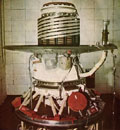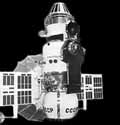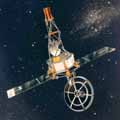|
Planet Venus
|
|
Facts & Information
|
Surface of Venus (artist's impression)

Maat Mons (NASA Magellan Image)
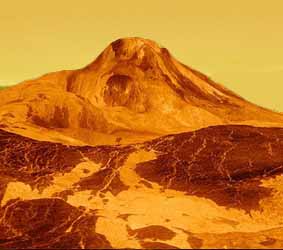
Planet Venus Facts
Venus is the second planet from the sun and very similar in size to the Earth, its diameter is only 400 miles (644 km) smaller than Earth.
At its closest point to Earth the planet is a mere 24 million miles away (38 million km).
It orbits the sun at an average distance of 67 million miles (108 million km).
The planet orbits around the sun every 225 days but rotates on its own axis slower than any other planet, taking 243 days compared to 24 hours on Earth.
Meaning a day on Venus is longer than its year! It also rotates in the opposite direction of the other planets.
It is surrounded by extremely thick cloud making it impossible to see the surface from orbit without radar or radio equipment.
The force of gravity is only 12% less than we have on Earth but the extreme weight of atmospheric pressure would crush a human.
Apart from the moon Venus is the brightest object in the night sky.
It was the first planet to be observed by a passing spacecraft.
Surface, Atmosphere & Temperature
Surface
About 65 percent of Venus is covered by flat plains, it also has mountains, canyons and valleys. There are thousands of volcanos on Venus, some up to 150 miles (240km) in diameter.
Venus also has ring-like structures called coronae which do not exist on Earth.
Atmosphere
The atmosphere of Venus is heavier than any other planet. It consists mainly of carbon dioxide with small amounts of nitrogen and water vapor.
Temperature
Extremely hot! The temperature at the uppermost clouds of Venus average about 13C (55F) however the surface temperature is a baking 465C (870F), the hottest surface
of any planet in the solar system.
Planet Venus Statistics
Diameter: 7,521 miles (12,104 km)Average Distance from Sun: 67 million miles (108 million km)
Orbital Period: 225 days
Rotation Period: 243 days
Maximium Surface Temperatures: 465C (870F)
Minumum Surface Temperatures: same as maximum
Gravity: 8.87 m/s2 (91% Earth's Gravity)
Density: 5.24 g/cm3 (95% Earth's Density)
Mass: 4.8685 x 1024 kg (81.5% Earth's Mass)
Volume: 9.284 x 1011 km3 (88% Earth's Volume)
Atmosphere: 96% Carbon dioxide, 3.5% Nitrogen, 0.015% Sulfur dioxide, 0.007% Argon, 0.002% Water vapor, 0.001 7% Carbon monoxide, 0.001 2% Helium.
| Moons & Origin of Name |
| Life on Venus |
Venus has no moons.
The planet was named by the Romans after the Goddess of Love.
The planet was named by the Romans after the Goddess of Love.
Due to the extreme heat it is highly unlikely any lifeforms could exist on the surface, airborne life forms could exist in temperate high clouds.
| Venus, Earth's Twin? |

Venus is often referred to as Earth’s sister planet or even twin. This is mainly due to the fact that it is very similar in size to our own planet. As it turns out we share other similarities, the mass, density and gravity of Venus are all very similar to Earths. Indeed studies have shown that a few billions years ago it had liquid water flowing over its surface and may well have harboured primitive lifeforms. Unfortunately for the planet there are also fundamental differences which means that while Earth is a hospitable world teeming with life, Venus is a choked, oven baked desert.
The atmospheres of both worlds are very different, Earth’s is thin and nitrogen based whereas the atmosphere on Venus is extremely thick and composed almost entirely of carbon dioxide. Ninety percent of Earth’s atmosphere is within just 6 miles (10 km) of its surface, on Venus it would be 30 miles (50 km) from its surface before reaching 90% of its atmosphere. As a result of having the heaviest atmosphere of any planet in the solar system atmospheric pressure on Venus is a massive 90 times stronger than on Earth, the equivalent of being more than a kilometre under the ocean, a human being would be crushed in these conditions. Perhaps the biggest difference is the intense heat, surface temperatures can reach an incredible 465C (870F) which is hot enough to melt lead. So where did it all go wrong for our twin planet? Well unfortunately it was just too close to the sun. The water it once had flowing across its surface quickly evaporated and without the cleansing effect of rain huge amounts of carbon dioxide built up in its atmosphere from intense volcanic activity. This created a runaway greenhouse effect, our twin reached the point of no return ending up with the hottest surface temperature of any planet in the solar system.
The atmospheres of both worlds are very different, Earth’s is thin and nitrogen based whereas the atmosphere on Venus is extremely thick and composed almost entirely of carbon dioxide. Ninety percent of Earth’s atmosphere is within just 6 miles (10 km) of its surface, on Venus it would be 30 miles (50 km) from its surface before reaching 90% of its atmosphere. As a result of having the heaviest atmosphere of any planet in the solar system atmospheric pressure on Venus is a massive 90 times stronger than on Earth, the equivalent of being more than a kilometre under the ocean, a human being would be crushed in these conditions. Perhaps the biggest difference is the intense heat, surface temperatures can reach an incredible 465C (870F) which is hot enough to melt lead. So where did it all go wrong for our twin planet? Well unfortunately it was just too close to the sun. The water it once had flowing across its surface quickly evaporated and without the cleansing effect of rain huge amounts of carbon dioxide built up in its atmosphere from intense volcanic activity. This created a runaway greenhouse effect, our twin reached the point of no return ending up with the hottest surface temperature of any planet in the solar system.
| Planet Venus - Images and Video |
Surface of Venus (Venera 13) 1981
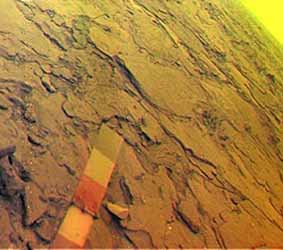

Radar images of the Venusian surface
Venus under the clouds


|
Planet Venus - Vital Statistics
Comparison with Earth
|
Diameter: 7,521 miles (12,104 km)
Average Distance from Sun: 67 million miles (108 million km)
Orbital Period: 225 days
Rotation Period: 243 days
Maximium Surface Temperatures: 465C (870F)
Minumum Surface Temperatures: same as maximum
Gravity: 8.87 m/s2 (91% Earth's Gravity)
Density: 5.24 g/cm3 (95% Earth's Density)
Mass: 4.8685 x 1024 kg (81.5% Earth's Mass)
Volume: 9.284 x 1011 km3 (88% Earth's Volume)
Atmosphere: 96% Carbon dioxide, 3.5% Nitrogen, 0.015% Sulfur dioxide, 0.007% Argon, 0.002% Water vapor, 0.001 7% Carbon monoxide, 0.001 2% Helium,
0.000 7% Neon.
Average Distance from Sun: 67 million miles (108 million km)
Orbital Period: 225 days
Rotation Period: 243 days
Maximium Surface Temperatures: 465C (870F)
Minumum Surface Temperatures: same as maximum
Gravity: 8.87 m/s2 (91% Earth's Gravity)
Density: 5.24 g/cm3 (95% Earth's Density)
Mass: 4.8685 x 1024 kg (81.5% Earth's Mass)
Volume: 9.284 x 1011 km3 (88% Earth's Volume)
Atmosphere: 96% Carbon dioxide, 3.5% Nitrogen, 0.015% Sulfur dioxide, 0.007% Argon, 0.002% Water vapor, 0.001 7% Carbon monoxide, 0.001 2% Helium,
0.000 7% Neon.
Diameter: 7,926 miles (12,756 km)
Average Distance from Sun: 93 million miles (150 million km)
Orbital Period: 365.24 days
Rotation Period: 23.934 hours
Maximium Surface Temperatures: 58C (136F)
Minumum Surface Temperatures: -88C (-126F)
Gravity: 9.766 m/s2
Density: 5.515 g/cm3
Mass: 5.9737 x 1024 kg
Volume: 1.0832 x 1012 km3
Atmosphere: 78.08% nitrogen, 20.95% oxygen, 0.93% argon, 0.038% carbon dioxide, water vapour makes up around 0.4% of Earth's atmosphere depending on climatic conditions.
Average Distance from Sun: 93 million miles (150 million km)
Orbital Period: 365.24 days
Rotation Period: 23.934 hours
Maximium Surface Temperatures: 58C (136F)
Minumum Surface Temperatures: -88C (-126F)
Gravity: 9.766 m/s2
Density: 5.515 g/cm3
Mass: 5.9737 x 1024 kg
Volume: 1.0832 x 1012 km3
Atmosphere: 78.08% nitrogen, 20.95% oxygen, 0.93% argon, 0.038% carbon dioxide, water vapour makes up around 0.4% of Earth's atmosphere depending on climatic conditions.
| Future and Past Missions to Venus |
Planet-C
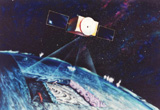 Launch: 2010
Launch: 2010Arrival: 2011
Agency: JAXA (Japan)
Designed to study the atmospheric dynamics of the planet. It will also measure atmospheric temperatures and look for evidence of volcanic activity and lightning.
Venus Express
 Launch: November 2005
Launch: November 2005Arrival: April 2006
Agency: ESA (Europe)
Venus Express is currently in orbit around Venus and has recently indicated that the planet is still volcanically active.
Messenger
 Launch: August 2004
Launch: August 2004Arrival: October 2006
Agency: NASA
Messenger has made 2 flybys of the planet on its way to Mercury. The opportunities were used to test scientific equipment on the craft.
Cassini-Huygens
 Launch: October 1997
Launch: October 1997Arrival: April 1998
Agency: NASA/ESA (Europe)
The spacecraft used the planet for two gravity assists on its way to Saturn.
Magellan
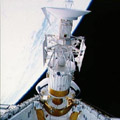 Launch: May 1989
Launch: May 1989Arrival: August 1990
Agency: NASA
By the end of its mission Magellan had mapped 98% of the planet using advanced radar techniques.
Galileo
 Launch: October 1989
Launch: October 1989Arrival: February 1990
Agency: NASA
Galileo flew past Venus on its way to Jupiter taking 81 images of the planet.
Vega 1
 Launch: June 1983
Launch: June 1983Arrival: October 1983
Agency: Soviet Union
Vega 1 deployed a probe into the planet's atmosphere which measured temperature, pressure and wind velocity.
Venera 15 and 16
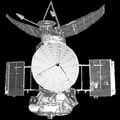 Launch: June 1983
Launch: June 1983Arrival: October 1983
Agency: Soviet Union
Venera 15 and 16 created a radar map of the planet over a joint mission lasting 8 months.
Venera 14
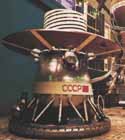 Launch: November 1981
Launch: November 1981Arrival: March 1982
Agency: Soviet Union
Venera 14's lander successfully touched down on the planet's surface sending back 14 images and a mechanical arm collected a sample for testing. The craft survived for 57 minutes before finally succumbing to the intense pressure. (Lander pictured left).
Venera 13
 Launch: October 1981
Launch: October 1981Arrival: March 1982
Agency: Soviet Union
Venera 13's lander successfully touched down sending back the first colour images of the surface. It also collected and examined a sample with a mechanical arm. The craft survived for 2 hours before succumbing to the extreme heat and pressure. (Orbiter pictured left).
Pioneer Venus 2
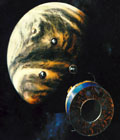 Launch: May 1978
Launch: May 1978Arrival: December 1978
Agency: NASA
Pioneer Venus 2 consisted of four separate atmospheric probes. Each probe took atmospheric measurements as they descended through the cloud layer. One of the probes survived to transmit data for over an hour after it impacted with the surface.
Pioneer Venus 1
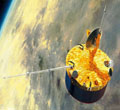 Launch: May 1978
Launch: May 1978Arrival: December 1978
Agency: NASA
Used radar to map most of the planet. The spacecraft remained in orbit until August of 1992, when it used up all its fuel and burnt up in the atmosphere.
Venera 10
 Launch: June 1975
Launch: June 1975Arrival: October 1975
Agency: Soviet Union
Successfully landed a probe on the planet's surface. It transmitted images from the surface and sent back data about clouds and the surface environment.
Venera 9
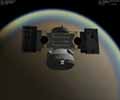 Launch: June 1975
Launch: June 1975Arrival: October 1975
Agency: Soviet Union
Successfully landed a probe on the planet's surface. It became the first spacecraft to transmit a picture from the surface of another planet. Also sent back information on the Venusian clouds, atmospheric composition, and light levels
Venera 8
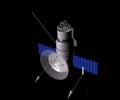 Launch: March 1972
Launch: March 1972Arrival: July 1972
Agency: Soviet Union
Successfully landed a probe on the planet's surface. The probe transmitted data for 50 minutes, confirming a very high surface temperature and crushing atmospheric pressure. It also measured the light level on its surface and found it suitable for surface photography.
Venera 7
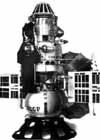 Launch: August 1970
Launch: August 1970Arrival: December 1970
Agency: Soviet Union
Successfully landed a probe on the planet's surface. The probe became the first spacecraft to return data from the surface of another planet. It reported surface temperatures of 475°C and atmospheric pressures 90 times greater than Earth's.
Venera 5 and 6
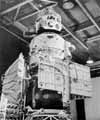 Launch: January 1969
Launch: January 1969Arrival: May 1969
Agency: Soviet Union
Venera 5 and 6 descended into the Venusian atmosphere sending back data for just over 50 minutes before succumbing to the intense pressure.
Mariner 5
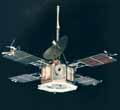 Launch: June 1967
Launch: June 1967Arrival: October 1967
Agency: NASA
Flew within 4000 miles (2,400 km) of the planet measuring a surface temperature of 267C.

